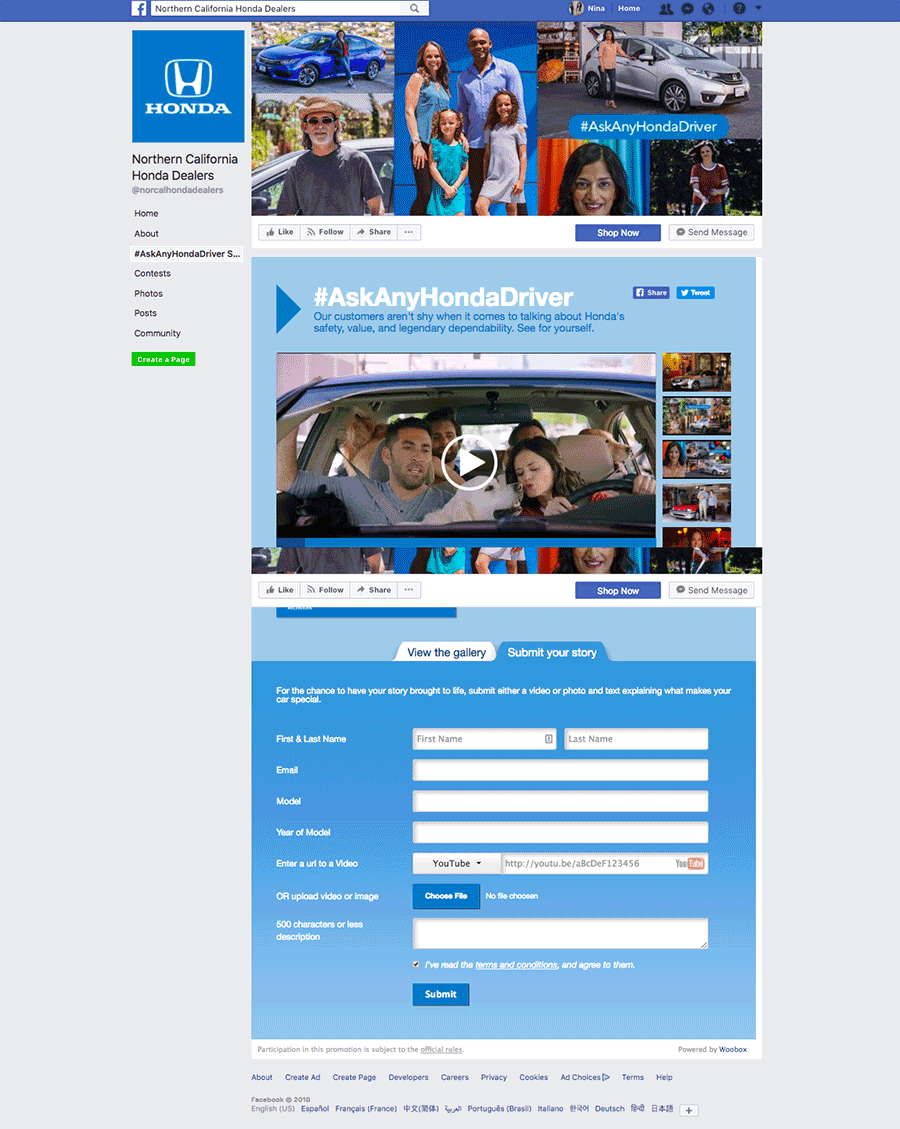There is a fatal mistake many Facebook advertisers and marketing professionals are not savvy to while launching their first few campaigns.
It’s called “Set it and Forget it,” previously covered in our 3 step process to create eye-catching Facebook ads for contests.
“Set it and Forget it” means that an ad campaign (Facebook, Adwords, etc.) is launched and never monitored (“forgotten about”) until the end of the campaign.
Monitoring your campaigns while they are running is just as important as measuring the results of completed campaigns. In this article, we are going to cover how to efficaciously monitor and measure your current and future campaigns.
Step 1: Understanding and Setting Metrics for Your Facebook Campaign
Before creating your campaign, it’s important to understand the primary goal(s) and result you would like to see. This tends to be unnecessarily overcomplicated, so let’s make it simple. Ask yourself the following question.
What goal am I looking to achieve with this campaign that directly supports a company-wide goal?
Once you have the answer to this question, your most important metrics will be those that help measure if this goal was attained.
Let’s take a look at an example. Here is a giveaway campaign that Brook created for their new product, X One, using Woobox.

There are two main goals for this campaign that can tie directly into supporting a company at large.
- Brook is looking to pre-sell their product for Xbox One and is a new company, so the goal would be to generate sales.
- Brook is wanting to build their brand awareness and recognition since they’re a newer product.
Once you know your goal(s), you can choose metrics that most directly correlate.
Here are examples of some metrics to measure Facebook campaigns in common categories:
- Performance: Results, Reach, Impressions, Cost Per Result, People Taking Action, 3-Second Video Views, Video Percentage Watched, Video Average Watch Time, etc.
- Engagement: People Taking Action, Post Reactions, Post Comments, Post Shares, Link Clicks, Page Likes, Cost Per Link Click, Offer Claims, Event Responses, Sign-Ups, etc.
- Performance and Clicks: Cost Per 1,000 Impressions, Link Clicks, Cost Per Link Click, CTR, Clicks, etc.
Going back to our example above, here are some metrics that would make sense for Brook to use to measure their campaign.
- Possible metrics for the goal of generating sales: Number of Pre-Sales, Revenue Generated from Pre-Sales, Cost Per Link Click, Cost per Website Conversion, Cost per Website Purchase, Registrations Complete
- Possible metrics for the goal of generating brand awareness: Post Reactions, Post Comments, Post Shares, Reach, Impressions, Page Likes, Results
Remember: It is your team’s call to choose which metrics are most important. Once selected, you can get even more specific and assign numbers to each metric to know your intended target range. Keep a log of campaign results, so that as you launch new campaigns you can see where you started, and adjust your metric numbers as you go along. You will be able to create baseline metrics using the median of the culmination of your metric results. Aim to continue to improve those as you craft new campaigns and ad sets.
Step 2: Monitor Active Facebook Campaigns
You need to monitor your campaigns while they are running and after they have completed.
Repeat: You need to monitor your campaigns while they are running.
It’s crucial to manage your campaigns while they’re running, making any necessary changes like increasing budgets, stopping ads, editing copy, etc. Campaign management enables you to discover what’s working, and what’s not working. This gives the ability to save and reallocate ad dollars that would otherwise be wasted.
Remember, advertising is constant testing and adjusting against feedback from incoming data.
Okay, all that said, let’s talk about tips for monitoring your ad campaigns.
Tip 1: Make the Ads Manager page on Facebook your homepage
Ads Manager is your number one tool to check your campaign stats, and you should be visiting this page at least once a day while your campaigns are running.
Tip 2: Use Ads Manager reports
Ads Manager will show you a summary of all of your campaigns. This includes things like daily spend, click-through rates, and engagement. Do you have multiple campaigns running? This is where you can compare and see which campaigns are performing the best, speculate why, and adjust or remove other campaigns that aren’t doing as well.
To look at the stats of individual ads, just click on the ad you want to view, and you’ll see all of the most up-to-date details on its performance.
Tip 3: Make sure you are checking the appropriate stats
This is where you can use the metrics you’ve set for your campaign(s) and see how each ad is contributing (or hindering) those desired results and make adjustments.
All of the stats Ads Manager has do not matter; what matters are the ones that support the goal(s) you’ve set for your ads and campaign.
Bonus: An under-tested factor in campaign success is the audience being targeted. Make sure to test the quality and relevancy of your audience during the monitoring process.
Let’s look at an example incorporating what we’ve talked about.
Say that, as Northern California Honda Dealers did below using Woobox, you create a video contest with a specific hashtag:

Two goals that would make the most sense for this campaign are video submissions and lead generation.
So, what would be a good strategy for successfully monitoring this campaign? You would want each ad targeting several different audience groups, using the same ad with multiple audiences. This allows you to observe the audiences who’re more responsive to your campaign.
After the ads run for a day or two, begin monitoring results, looking at the overall performance of the campaigns as a cooperative whole. Next, dig into each ad, giving extra focus to your top performing and bottom performing ads.
Meaningful metrics for this campaign (based on the above two goals) would be the number of form completions, the number of video plays, the click-through rate for the “See Latest Offers” button, reach, shares, and comments.
Next, isolate specific elements of the ads. Things like the copy, visuals, and target audiences from your top performing ads are good choices.
Once you’ve done the above audit, you’re ready to tweak those elements of your bottom performing ads.
Repeat this process daily, whenever possible. Don’t be afraid to end ads early if their performance fails to increase.
Step 3: View and Measure Facebook Campaign Results
There is much to learn in this last step that we could publish an entire book.
So, for the sake of time and simplicity, let’s cover critical points essential to understanding when measuring the results of your campaign after it has ended.
Here are 3 different yet crucial insights when measuring your Facebook ad campaign results.
1. Choose the Right Measurement Solution
Facebook offers three ways to measure ads derived from your audience, brand, or sales.
Let’s cover each separately to understand which works best for your specific goal, and which Facebook products support each goal measurement.
Audience Outcomes: Measures how you reach your target audience
This helps you see who you are reaching with your ads, which ad will produce more significant ROI, who saw your ads, if your ads are relevant to your audience, and more.
Facebook recommends using the following to measure: Ads Reporting through Ads Manager, Split Testing, and Audience Insights.
Brand Outcomes: Measures how your ads are affecting your brand goals
This helps you better understand abstract data like your ad recall, how to make your brand stand out, shifts in perception of the brand, how memorable the ads were, how much awareness the campaign generated, and more.
Facebook recommends using the following to measure campaigns: Ads Reporting and Brand Lift
Before we continue, we have to cover what Brand Lift is, because a lot of marketers are unaware of this powerful and free feature.
A brand lift is a free study that can help you understand how well your campaign resonates with people. This is a free study Facebook provides for qualifying campaigns. You will have to reach out to a Facebook Account Representative to create this study.
Let’s say you launched a quiz campaign like this one created on Woobox to build brand awareness, brand recognition, and to learn more about your audience.

Looking at your Ads Manager account will only offer so much insight since branding is a subjective type of goal. By polling those who saw your ads, Facebook will create a study for qualifying campaigns to help you understand the hard-to-measure metrics like ad recall, brand awareness, and message association.
To learn more about how to set up a Brand Lift study go here.
Sales Outcomes: Measures how your ads affect both sales and conversions
This metric helps you understand things like correlations between purchases, how mobile impacts your spend, evaluate business driven by ads, how your ads impact your sales goals and more.
Facebook recommends using the following to measure: Ads Reporting and Test and Learn (which you can learn more about here)
2. Looking At Data by Breakdowns
You can break up your reporting of a specific campaign, ad set, or ad by using a button called “Breakdown”. Breakdown offers to report around how your campaign did in three categories: By Delivery, By Action, and By time. Each one gives different, yet valuable insights.
Here is a description of each category.
- Breakdown By Delivery: This shows who saw your campaign and includes data like age, geographic location by country, region, and designated market area.
- Breakdown By Action: This will show you the actions people took as a result of your ad such as clicks, comments, etc.
- Breakdown By Time: Here you see information based on the time-period it happened.
You can also combine breakdowns to see new insights, for example, connecting Time and Region can tell you what audience group was most active in your region at a specific time.
3. Compare Current Results To Previous Results
If this is your first campaign, you will take your results and keep them filed as a baseline to use to compare to campaigns with similar goals in the future. This will also serve as a reference of both what has worked and what has not worked so you can craft your new campaigns with some data insight, instead of going in blindly.
If this is not your first campaign, make sure you take the time to look at all of the metrics you chose, and compare them with previous results. Are your metrics improving? Are your results declining? What did you do differently in this campaign than the previous one? What worked well in another campaign that you can implement again in the future? These types of questions will help you begin to create a log of both data and possibilities to consider when you create new campaigns.
Closing Thoughts
All of the campaign examples above were created using Woobox. We help over 4 million brands around the world create beautiful campaigns quickly and effortlessly. It is free to build campaigns using the Woobox platform, and a subscription is only required to publish and run a campaign.
Your free Woobox account will allow you to create unlimited giveaways, contests, quizzes, polls, or any other promotion. Start creating eye-catching campaigns with Woobox for free today.
